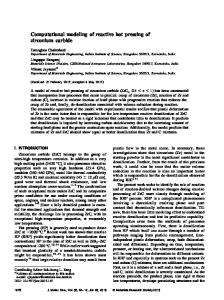Reactive hot pressing of aluminum matrix composites
- PDF / 331,219 Bytes
- 5 Pages / 612 x 792 pts (letter) Page_size
- 30 Downloads / 475 Views
MATERIALS RESEARCH
Welcome
Comments
Help
Reactive hot pressing of aluminum matrix composites H.J. Brinkman,a) J. Duszczyk, and L. Katgerman Laboratory of Materials Science, Delft University of Technology, Delft, The Netherlands (Received 23 April 1999; accepted 3 August 1999)
A method is described for the production of dense aluminum matrix composites from elemental powders in one processing step by reactive hot pressing (RHP). It encompasses both the exothermic conversion of reactants to composite product and the following hot compaction of the porous composite product. The RHP method described in this paper takes into account the gas evolution accompanying the exothermic process, ensures complete conversion of reactants, and avoids adverse reactions between aluminum matrix and graphite tooling material. In situ sample temperature measurements enable proper process control, in particular the timing of the full densification step of the hot reaction product.
I. INTRODUCTION
Manipulation of exothermic reactions in powder mixtures is used for the production of a range of advanced materials such as ceramics, intermetallics, and composites.1 The process is based on the use of chemical reactions that, once initiated, are sufficiently exothermic to sustain the complete conversion. The initiation of reaction is performed by either igniting a part of the compact, the propagating mode, or by heating the compact on the initiation temperature. These exothermic reaction processes are known under a variety of names: reactive synthesis, self-propagating high-temperature synthesis (SHS), combustion synthesis, and XD™.2 For metal-matrix-composite materials reactive synthesis has the important advantage that the reinforcements are formed in situ in the matrix. This inherently gives a clean interface between particle and matrix, which results in good bonding properties. Further advantages are the small second-phase particle size that can be realized over a wide range of reinforcement volume fractions with proper process control. In addition the thermodynamic stability and good wetting between matrix and reinforcement that result from the high-temperatures formation of the composite system is promising for elevated temperature applications of these composite materials.3,4 For aluminum matrix composites the phases TiB2 or TiC are a preferred reinforcement particles choice because their formation in the aluminum matrix is sufficiently exothermic to sustain a self-propagating synthesis.2
a)
Address all correspondence to this author. e-mail: [email protected]
4246
http://journals.cambridge.org
J. Mater. Res., Vol. 14, No. 11, Nov 1999 Downloaded: 12 Mar 2015
The major limitation of reactive synthesis is the invariable high level of porosity in the reaction products, typically about 50%. The porosity results from multiple sources; the change in molar volume during the reaction, the evolution of gases during the reaction, and the initial porosity in the cold compacted mixture.5 Thus, an additional compaction operatio
Data Loading...











